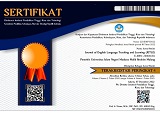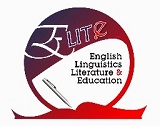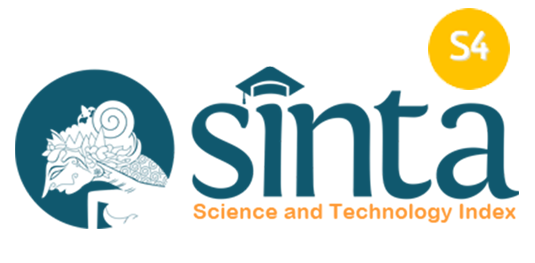Exploring students’ perception on the use of Instagram as a platform in Creative Writing course
Abstract
As a product of Information and Communication Technology (ICT), the commonly-used social media Instagram offers a new platform of digital writing with unique features that could facilitate and accommodate the exploration of creative writing genre. Through this study, 27 university students’ perception were explored with qualitative descriptive study using open-ended questionnaire, interview and documentation to find out how they perceived this new platform in their writing journey in comparison to university website or traditional means like printed paper. For the findings, variety of students perception were showed in three different spectrums using thematic analysis: 1) majority of the students perceived their experience as positive one due to Instagram benefits as source of inspiration, creativity endeavour and larger engagement for their writing product; 2) some of the students also offered their negative experience in regards to word limitation and insecurity of uploading to public; 3) meanwhile, the more neutral one admitted that Instagram’s benefit was just similar to other platforms. This study’s significant can help future lecturer/teacher in adapting and evaluating the advantage and disadvantage of this application implementation for the improvement of future class.
Keywords
Full Text:
PDFReferences
Akhiar, A., Mydin, A.-A., & Kasuma, S. A. (2017). Students’ Perceptions and Attitudes Towards the Use of Instagram in English Language Writing. Malaysian Journal of Learning and Instruction (MJLI), Special issue on Graduate Students Research on Education, 47-72.
Almukhlissy, Y. Y. (2020). Students’ Perception Toward the Use of Instagram in Speaking Class at University of Muhammadiyah Malang. [Published Sarjana's Thesis]. Retrieved from UMM Institutional Repository: https://eprints.umm.ac.id/64384/
Barton, D., & Potts, D. (2013). Language Learning Online as a Social Practice. TESOL Quarterly, DOI:10.1002/tesq.130.
Braun, V., & Clarke, V. (2012). Thematic Analysis. Washington (DC): American Psychological Association.
Cornali, F., & Cavaletto, G. M. (2021). Emerging Platform Education: What Are the Implications of Education Processes' Digitization? In A. S. Moura, P. Reis, & M. N. Cordeiro, Handbook of Research on Determining the Reliability of Online Assessment and Distance Learning (pp. 359-378). DOI: 10.4018/978-1-7998-4769-4.ch015.
Dhyaningrum, A. (2017). Creative Writing for Non-Native English Students: a Challenge . International Conference on Arts and Culture.
Earnshaw, S. (2007). The Handbook of Creative Writing. Edinburgh: Edinburgh University Press.
Fu, J. S. (2013). ICT in Education: A Critical Literature Review and Its Implications . International Journal of Education and Development using Information and Communication Technology (IJEDICT), Vol. 9, Issue 1, pp. 112-125 .
Gasper, K. (2018). Do you see what I see? Affect and visual information. Cognition and Emotion 18(3), 405-421.
Gray, J. A., & DiLoreto, M. (2016). The Effects of Student Engagement, Student Satisfaction, and Perceived Learning in Online Learning Environments . NCPEA International Journal of Educational Leadership Preparation, Vol. 11, No. 1.
Insani, N. A. (2020). The Use of Instagram to Improve Students' Writing Skills in Descriptive Text. Published Sarjana's Thesis. Retrieved from Digital Library Unimus Makassar: https://digilibadmin.unismuh.ac.id/upload/11002-Full_Text.pdf
Irwanto. (2002). Psikologi Umum: Buku Panduan Mahasiswa. Jakarta Pusat: PT Prenhallindo.
Johnson, D. (2021, September). Instagram Character Limit in Post, Caption, & Comment. Retrieved from Bussiness 2 Community: https://www.business2community.com/instagram/instagram-character-limit-in-post-caption-comment-02430199
Kelly, R. (2015). An Exploration of Instagram to Develop ESL Learner's Writing Proficiency [Published Dissertation] . Retrieved from British Council ELT Master’s Dissertation Awards: Commendation: https://www.teachingenglish.org.uk/sites/teacheng/files/dissertation_for_publication_ulster_university.pdf
Lambert, V., & Lambert, C. (2012). Editorial: Qualitative Descriptive Research: An Acceptable Design. Editors: Pacific Rim International Journal of Nursing Research Vol. 16 No. 4, pp. 255-256.
Lestari, H. D., & Hartatik, S. F. (2021). Remote Teaching Strategies in Writing Skill Development Due to Covid-19 Pandemic. Journal of English Language Teaching and Learning (JETLE), 3(1), Article 1. https://doi.org/10.18860/jetle.v3i1.11959
Listiani, G. (2016). The Effectiveness of Instagram Writing Compared to Teacher. Journal of English Language Teaching 5 (1).
Marchewka, J. T., & Kostiwa, K. (2007). An Application of the UTAUT Model for Understanding Student Perceptions Using Course Management Software. Communications of the IIMA: Vol. 7: Issue 2, Article 10., Retrieved from:http://scholarworks.lib.csusb.edu/ciima/vol7/iss2/10.
Mintarini, T. S. (2014). ELESP Students' Perception on the Use of Blog in Creative Writing Class. Published Sarjana's Thesis. Retrieved from Repository Universitas Sanata Dharma: http://repository.usd.ac.id/id/eprint/3694
Ramalia, T. (2021). The Students’ Perspective of Using Instagram as a Writing Assignment Platform . J-SHMIC : Journal of English for Academic, Vol 8, No 2., 129.
Rohmana, W. I. M. (2022). The use of Livemocha: a platform for independent language learning. Abjadia: International Journal of Education, 7(1), 103-1013.
Rifa’i, I. B. (2019). Applying Think Talk Write in creative writing (A Case Study at SMP 14 Kota Serang). [Published Sarjana's Thesis]. Retrieved from UIN SMH Banten Institutional Repository: http://repository.uinbanten.ac.id/4830/
Schat, S. (2014). Exploring the Relationship between Perception and Education: Rediscovering Perceptual Theory and Its Impact on Teaching and Learning. Canadian Society for the Study of Education. Ontario: Brock University. Retrieved from Research Gate Conference: Canadian Society for the Study of Education: https://www.researchgate.net/publication/276918868_Exploring_the_Relationship_between_Perception_and_Education_Rediscovering_Perceptual_Theory_and_Its_Impact_on_Teaching_and_Learning
Venkatesh, V., Morris, M., Davis, G., & Davis, F. (2003). User Acceptance of Information Technology: Toward a Unified View. MIS Quarterly, Vol. 27, No. 3, 42-478.
DOI: https://doi.org/10.18860/jetle.v4i2.20675
Refbacks
- There are currently no refbacks.
Jalan Gajayana 50 Malang 65144, Jawa Timur, Indonesia

This work is licensed under a Creative Commons Attribution-ShareAlike 4.0 International License.
Indexed by





